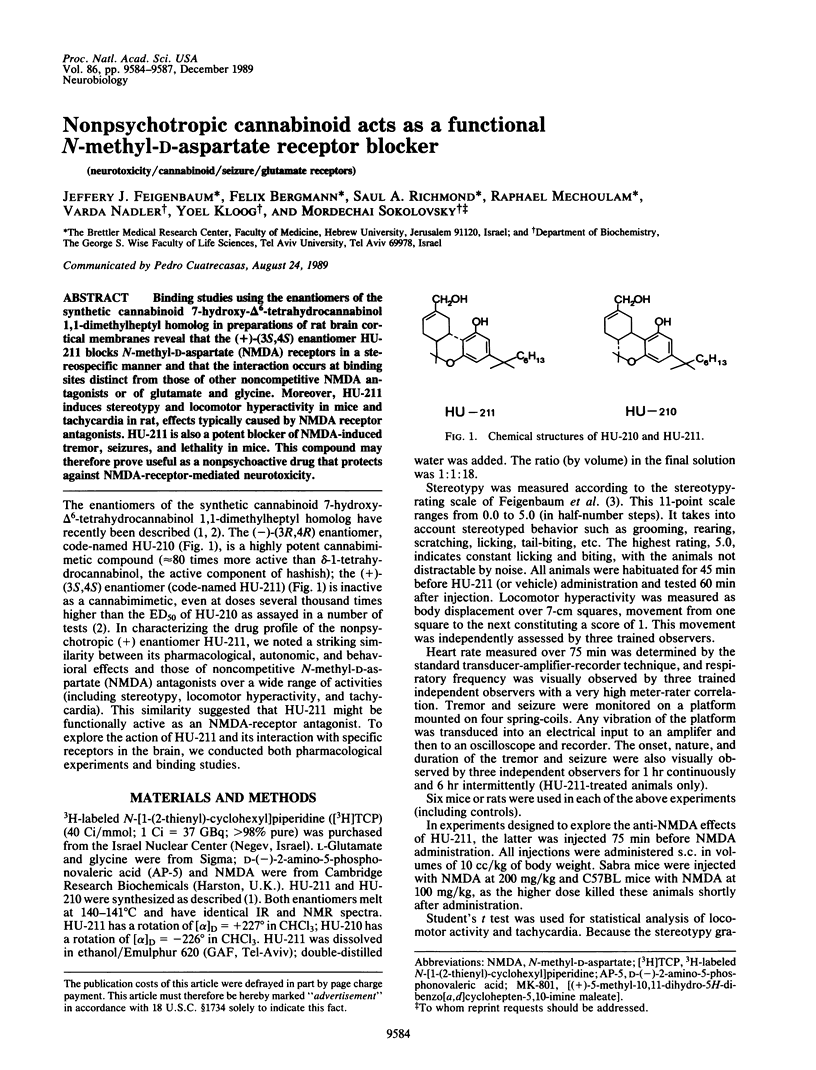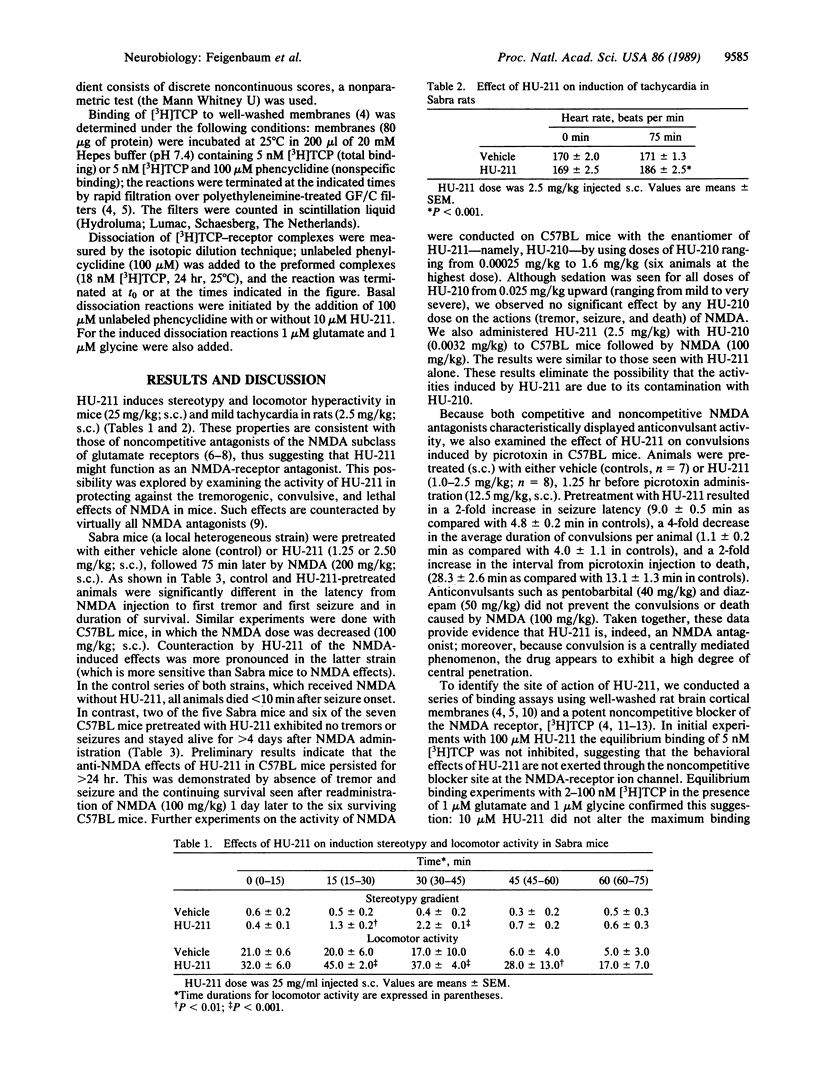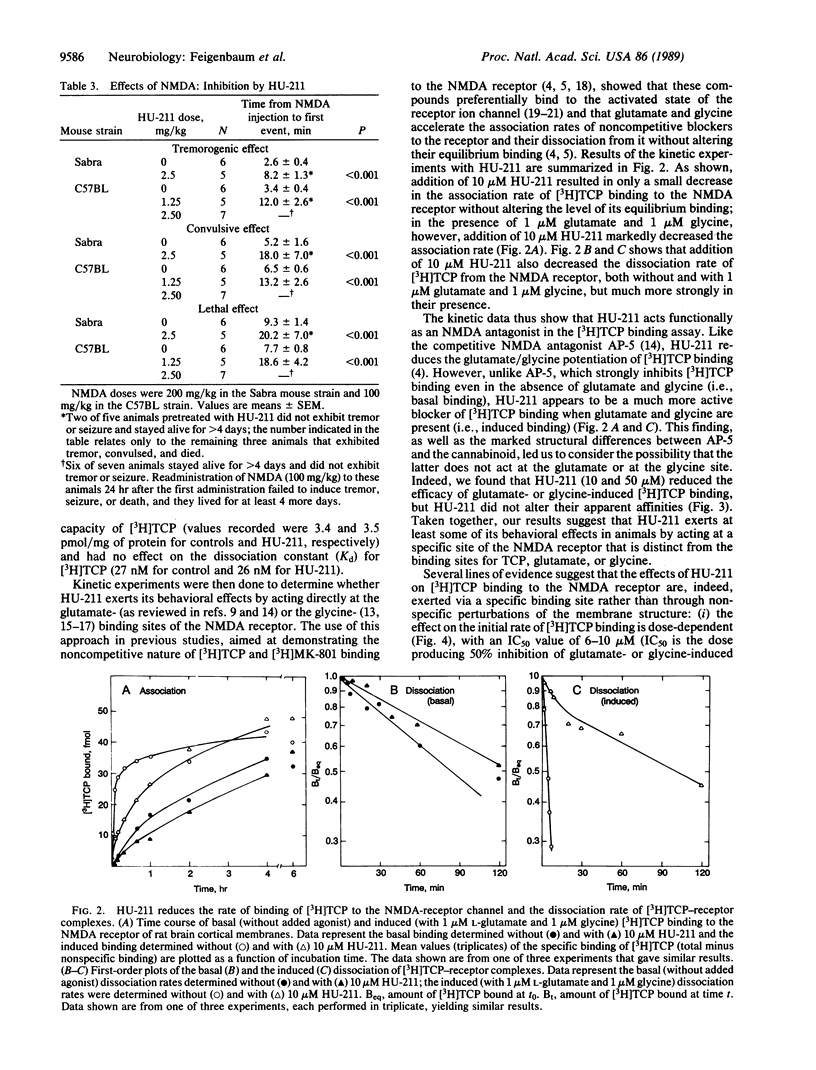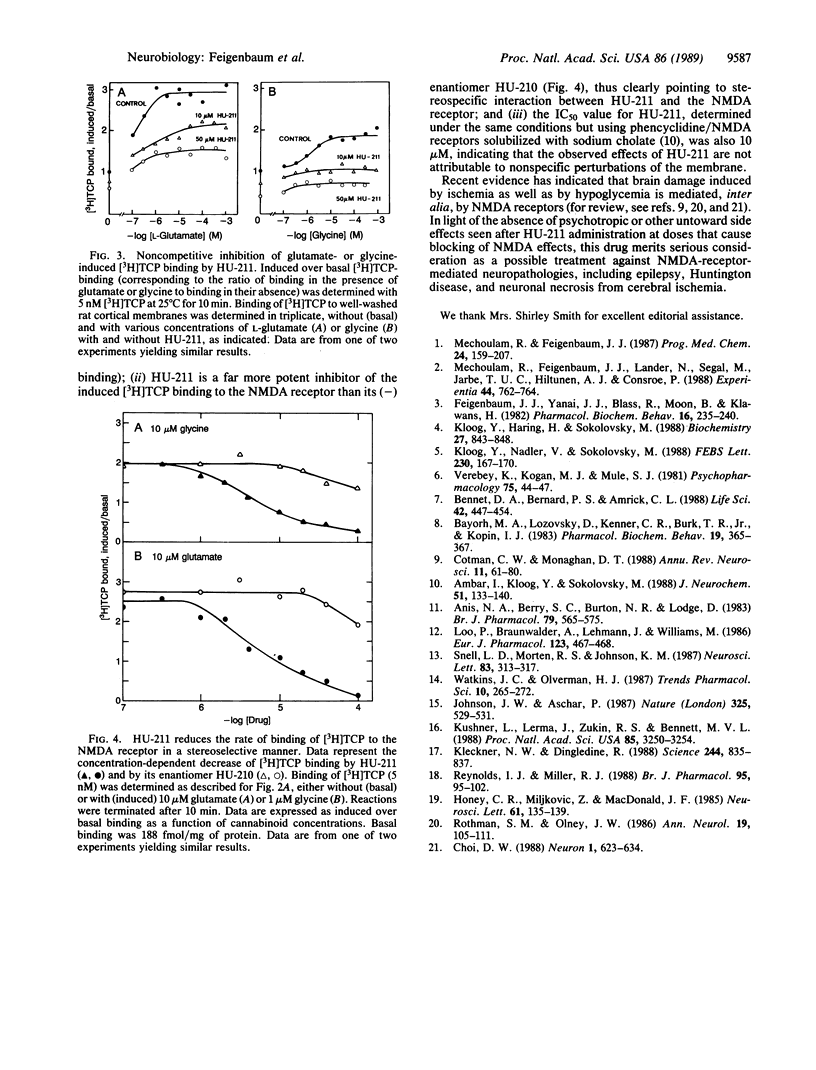Abstract
Binding studies using the enantiomers of the synthetic cannabinoid 7-hydroxy-delta 6-tetrahydrocannabinol 1,1-dimethylheptyl homolog in preparations of rat brain cortical membranes reveal that the (+)-(3S,4S) enantiomer HU-211 blocks N-methyl-D-aspartate (NMDA) receptors in a stereospecific manner and that the interaction occurs at binding sites distinct from those of other noncompetitive NMDA antagonists or of glutamate and glycine. Moreover, HU-211 induces stereotype and locomotor hyperactivity in mice and tachycardia in rat, effects typically caused by NMDA receptor antagonists. HU-211 is also a potent blocker of NMDA-induced tremor, seizures, and lethality in mice. This compound may therefore prove useful as a nonpsychoactive drug that protects against NMDA-receptor-mediated neurotoxicity.
Full text
PDF



Selected References
These references are in PubMed. This may not be the complete list of references from this article.
- Ambar I., Kloog Y., Sokolovsky M. Solubilization of rat brain phencyclidine receptors in an active binding form that is sensitive to N-methyl-D-aspartate receptor ligands. J Neurochem. 1988 Jul;51(1):133–140. doi: 10.1111/j.1471-4159.1988.tb04846.x. [DOI] [PubMed] [Google Scholar]
- Anis N. A., Berry S. C., Burton N. R., Lodge D. The dissociative anaesthetics, ketamine and phencyclidine, selectively reduce excitation of central mammalian neurones by N-methyl-aspartate. Br J Pharmacol. 1983 Jun;79(2):565–575. doi: 10.1111/j.1476-5381.1983.tb11031.x. [DOI] [PMC free article] [PubMed] [Google Scholar]
- Bayorh M. A., Lozovsky D., Rice K. C., Burke T. R., Jr, Kopin I. J. Cardiovascular and plasma prolactin responses to stereoisomers of phencyclidine. Pharmacol Biochem Behav. 1983 Aug;19(2):365–367. doi: 10.1016/0091-3057(83)90066-7. [DOI] [PubMed] [Google Scholar]
- Bennett D. A., Bernard P. S., Amrick C. L. A comparison of PCP-like compounds for NMDA antagonism in two in vivo models. Life Sci. 1988;42(4):447–454. doi: 10.1016/0024-3205(88)90083-5. [DOI] [PubMed] [Google Scholar]
- Choi D. W. Glutamate neurotoxicity and diseases of the nervous system. Neuron. 1988 Oct;1(8):623–634. doi: 10.1016/0896-6273(88)90162-6. [DOI] [PubMed] [Google Scholar]
- Cotman C. W., Monaghan D. T., Ganong A. H. Excitatory amino acid neurotransmission: NMDA receptors and Hebb-type synaptic plasticity. Annu Rev Neurosci. 1988;11:61–80. doi: 10.1146/annurev.ne.11.030188.000425. [DOI] [PubMed] [Google Scholar]
- Feigenbaum J. J., Yanai J., Blass R. B., Moon B., Klawans H. The effect of drugs altering striatal dopamine levels on apomorphine induced stereotypy. Pharmacol Biochem Behav. 1982 Feb;16(2):235–240. doi: 10.1016/0091-3057(82)90154-x. [DOI] [PubMed] [Google Scholar]
- Honey C. R., Miljkovic Z., MacDonald J. F. Ketamine and phencyclidine cause a voltage-dependent block of responses to L-aspartic acid. Neurosci Lett. 1985 Oct 24;61(1-2):135–139. doi: 10.1016/0304-3940(85)90414-8. [DOI] [PubMed] [Google Scholar]
- Johnson J. W., Ascher P. Glycine potentiates the NMDA response in cultured mouse brain neurons. Nature. 1987 Feb 5;325(6104):529–531. doi: 10.1038/325529a0. [DOI] [PubMed] [Google Scholar]
- Kleckner N. W., Dingledine R. Requirement for glycine in activation of NMDA-receptors expressed in Xenopus oocytes. Science. 1988 Aug 12;241(4867):835–837. doi: 10.1126/science.2841759. [DOI] [PubMed] [Google Scholar]
- Kloog Y., Haring R., Sokolovsky M. Kinetic characterization of the phencyclidine-N-methyl-D-aspartate receptor interaction: evidence for a steric blockade of the channel. Biochemistry. 1988 Feb 9;27(3):843–848. doi: 10.1021/bi00403a001. [DOI] [PubMed] [Google Scholar]
- Kloog Y., Nadler V., Sokolovsky M. Mode of binding of [3H]dibenzocycloalkenimine (MK-801) to the N-methyl-D-aspartate (NMDA) receptor and its therapeutic implication. FEBS Lett. 1988 Mar 28;230(1-2):167–170. doi: 10.1016/0014-5793(88)80664-1. [DOI] [PubMed] [Google Scholar]
- Kushner L., Lerma J., Zukin R. S., Bennett M. V. Coexpression of N-methyl-D-aspartate and phencyclidine receptors in Xenopus oocytes injected with rat brain mRNA. Proc Natl Acad Sci U S A. 1988 May;85(9):3250–3254. doi: 10.1073/pnas.85.9.3250. [DOI] [PMC free article] [PubMed] [Google Scholar]
- Loo P., Braunwalder A., Lehmann J., Williams M. Radioligand binding to central phencyclidine recognition sites is dependent on excitatory amino acid receptor agonists. Eur J Pharmacol. 1986 Apr 29;123(3):467–468. doi: 10.1016/0014-2999(86)90726-0. [DOI] [PubMed] [Google Scholar]
- Mechoulam R., Feigenbaum J. J., Lander N., Segal M., Järbe T. U., Hiltunen A. J., Consroe P. Enantiomeric cannabinoids: stereospecificity of psychotropic activity. Experientia. 1988 Sep 15;44(9):762–764. doi: 10.1007/BF01959156. [DOI] [PubMed] [Google Scholar]
- Mechoulam R., Feigenbaum J. J. Towards cannabinoid drugs. Prog Med Chem. 1987;24:159–207. doi: 10.1016/s0079-6468(08)70422-3. [DOI] [PubMed] [Google Scholar]
- Reynolds I. J., Miller R. J. Tricyclic antidepressants block N-methyl-D-aspartate receptors: similarities to the action of zinc. Br J Pharmacol. 1988 Sep;95(1):95–102. doi: 10.1111/j.1476-5381.1988.tb16552.x. [DOI] [PMC free article] [PubMed] [Google Scholar]
- Rothman S. M., Olney J. W. Glutamate and the pathophysiology of hypoxic--ischemic brain damage. Ann Neurol. 1986 Feb;19(2):105–111. doi: 10.1002/ana.410190202. [DOI] [PubMed] [Google Scholar]
- Snell L. D., Morter R. S., Johnson K. M. Glycine potentiates N-methyl-D-aspartate-induced [3H]TCP binding to rat cortical membranes. Neurosci Lett. 1987 Dec 29;83(3):313–317. doi: 10.1016/0304-3940(87)90106-6. [DOI] [PubMed] [Google Scholar]
- Verebey K., Kogan M. J., Mulè S. J. Phencyclidine-induced stereotype in rats: effects of methadone, apomorphine, and naloxone. Psychopharmacology (Berl) 1981;75(1):44–47. doi: 10.1007/BF00433500. [DOI] [PubMed] [Google Scholar]


